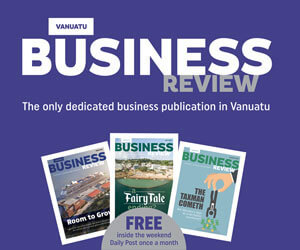Room to Grow
June 16, 2016 10:30 am | Posted in Features | Share now TwitterFacebook
At first glance, the new Luganville wharf looks like a vast expanse of nothing. But that’s kind of the point.
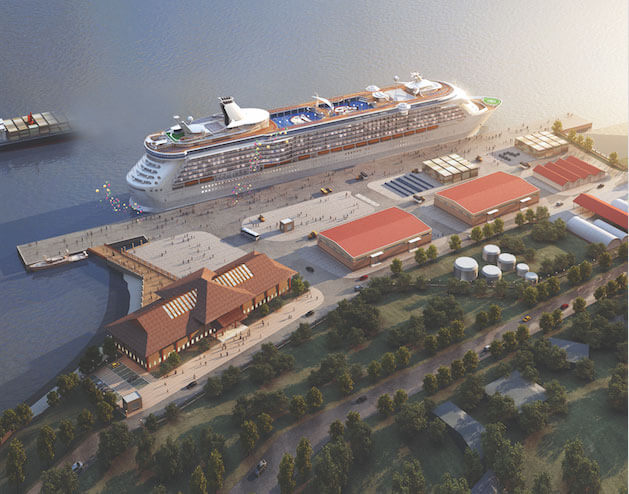
The 360-metre concrete and steel facility is big enough to fit a cruise ship and a moderately sized container ship simultaneously. Requiring over 10,000 tonnes of cement, including more than 400,000 bricks fabricated on-site, the project is almost out of scale with its surroundings.
Roughly 7,000 cubic metres of earth were moved in the construction process, and by the time construction is finished in June next year, the contractor will have constructed or refurbished 20 separate structures.
The project is managed by Shanghai Construction Group, or SCG, one of the large construction firms in the world. They cut their engineering teeth during the 1990s when political and economic conditions transformed their home city of Shanghai into what the New York Times called ‘a builder’s dream’.
Their highest profile project is the Shanghai Tower, currently the tallest edifice in China and second only to Dubai’s Burj Khalifa globally.
Not the Shanghai Tower
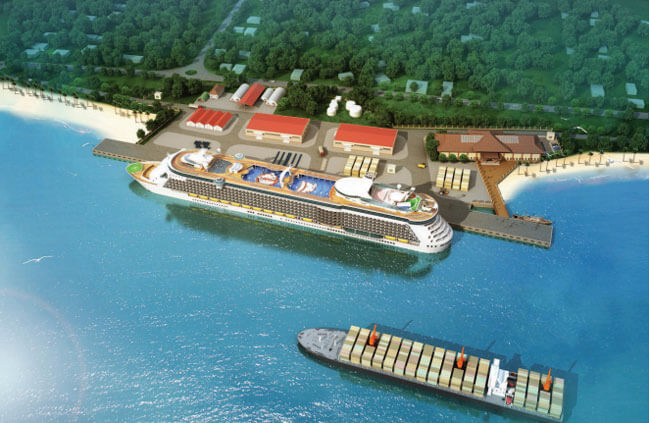
Luganville’s wharf project is nearly the opposite of the Shanghai Tower in every way. In its present state, it imposes a sense of space, even emptiness on the viewer. But that’s going to change. Artist’s renderings of the completed site promise what some industry watchers are calling ‘the best port facility in the Pacific islands.’
Company representatives quietly concur. During a tour of the construction site, the SCG project manager was modest, even diffident about his company’s achievements. But he couldn’t hide a shy smile when he spoke of the port building.
The concrete and steel structure features vaulted ceiling with skylights covering half its length. It will allow cruise ship passengers to bypass the dust and grime of the commercial port and enter Luganville proper through a building containing not just Immigration and Customs facilities, but refreshment stalls, craft displays, live entertainment, tour and transport booking.
The ever-present tang of copra in the air may be their only clue to the port’s other uses.
In the short- to mid-term at least, the smell of copra isn’t going away. Copra and related products still account for the majority of economic activity in the northern town. In 2014—the latest year for which public data exists—Vanuatu exported a little over 25,000 tonnes of copra, with a value of nearly VT 1.5 billion.
With world prices twice as high as they were in 2013, the numbers are only going to increase. Agriculture remains Santo’s biggest economic driver.
Tourist revenues are still modest, especially in comparison withPort Vila. Each year, only about15% of tourists ever visit Santo.In fairness, those who do make the trip provide good value to the economy. Primarily young—nearly two thirds of them are under fifty—and affluent, they stay about a week on average, spending a little over AU$ 1,000each in total .
Betting Big

The town is relying heavily on cruise ship customers to boost those numbers. While their stay on the island is shorter, and their average spend much smaller, it’s hoped that increased numbers will make the critical difference.
The Municipality has bet big on the economic benefits for small businesses in town. Every cruise ship day, Unity Park in the middle of town is festooned end-to-end with cloth-roofed stalls. Locals pay a small fee to rent one of the hundred-plus spaces.
But have they bet too big?
Glennis John is originally from Loltong village on Pentecost, but she’s lived in Luganville since she was a schoolgirl. She and her husband have been making and selling local handicrafts since long before the cruise ships started coming to town.
She’s deeply appreciative of the organisation and support provided by the Municipal Council and says that activities at the Park are extremely well organised. She has nothing but admiration for the organisation and support small vendors such as herself have received. But when asked how she’s benefited, she’s a little reticent.
The bottom line is that there are simply too many stalls and too few tourists. “Most of them don’t want to walk all the way here,” she says, “and the ones that do pass in front of all the other storefronts before they get here.”
By the time they reach the park, she says, they’ve already spent all they want to spend.
“Things will be better once we’re down in the port itself,” she says with conviction.
That is likely to be true, but questions remain about the number of vendors and the quality of their stock. Industry watchers worry that unless the number of vendor positions is reduced, nobody will profit enough to keep the local handicraft market viable.
Likewise, they complain that the majority of goods for sale are tacky imported gewgaws of limited appeal to tourists, and they fear that higher quality, hand-made crafts are being lost in the flood.
A wander through the bewildering array of stalls in the park seems to validate these concerns.
Port Vila residents will recognise some of these concerns. Local vendors have faced similar challenges.
Lesson Learned
Happily, Luganville has learned from some of Vila’s more bitter lessons. Traffic management at the wharf for local transport operators is carefully overseen by both Police and Vanuatu Mobile Force members.
The drivers themselves are determined to keep things on an even keel. Nobody rocks the boat as transports large and small shuttle between port and destination. Drivers are painstakingly civil with one another, and with their charges.
That’s not to say things are entirely hunky-dory. Speak to individual taxi drivers, and you’ll hear many of the same sentiments expressed by their Port Vila counterparts.
They feel that tour operators and larger scale transfer operations are profiting far more than they are.
On days when smaller ships are in port, they feel the pinch acutely. One driver claimed he’d simply stopped bothering to show up on cruise ship days. He did far better in town, he said, picking up the slack in local fares. He said that most of the tourists he transported were returning to the ship, not coming from it.
It’s clear, though, that no matter what economic pressures they may face, they are determined that visitors remember Santo as a welcoming, friendly, laid-back place. Buses, taxis and transports all queue in a blocked-off section of road, and pick up guests on a first-come, first-served basis.
Tour operators sure aren’t complaining. Each cruise ship arrival generates direct revenues of VT 20 – 30 million to local tour operators, the vast majority of whom are Ni Vanuatu running small operations. Adventures in Paradise has expended significant effort in promoting the quality and diversity of local attractions.
People working down at the wharf have nothing but praise for the Northern District Police commander, Wellie Samuel, for the work he’s done to create an orderly and productive workplace for local drivers.
A Merry Month
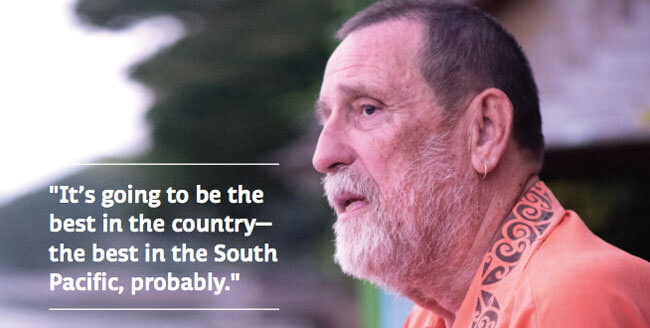
May marked the end of a hiatus in cruise ship arrivals. The announcement by the SCG that arrivals would be interrupted for a period of months drew the ire of numerous local business owners, especially tour and resort operators who were sure to suffer.
Dave Cross, who manages tour operations in Santo for Adventures in Paradise, says that his greatest frustration was with the lack of communication. The decision to suspend arrivals, he said, was made with little or no consultation concerning the impacts.
He estimates that the interruption cost the local economy hundreds of millions.
But all was forgiven when the Business Review caught up with tourism operators when the Pacific Aria was in town. It felt like the entire town had put on its glad rags to welcome the ship.
Asked about the soon to be completed port facility, Cross’ expression transforms itself. “It’s going to be the best in the country—the best in the South Pacific, probably.”
The tourism veteran is happy with the quality of the construction so far. A tour of the facility shows that SCG has not stinted on materials so far. Bricks from a small-scale brick-making plant imported by the contractor are being laid by hand atop a layer of sand in the new container facility. This will allow for shock absorption in the event of earthquakes, and for settling caused by heavy rains. It reduces maintenance costs as well, making surface damage easily repairable using only manual labour.
The entire site sits on a cement and steel mesh foundation 2 metres thick. Asked how the facility fared during a recent 7.3 temblor, the SCG project manager barely raised an eyebrow. The site is spec’ed to withstand earthquakes of more than an order of magnitude greater intensity.
Financing the Future
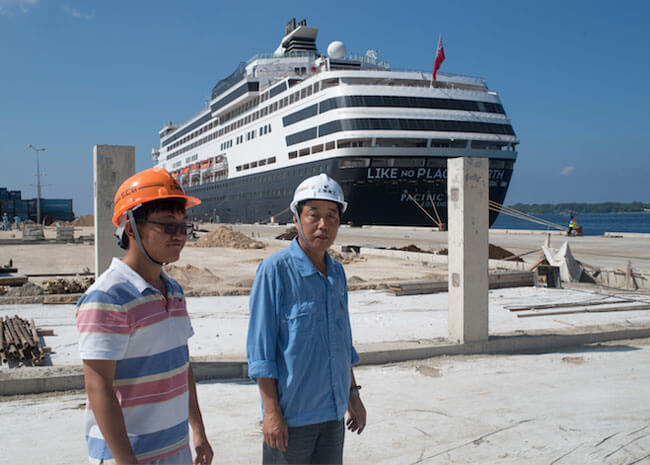
Such undisputed quality doesn’t come for free. With a price tag larger than the VT 7 billion Port Vila wharf project, it’s worth asking whether the country can afford it.
In 2013, the Pacific Institute of Public Policy issued a report citing the Chinese EXIM Bank in particular as one of several players behind Vanuatu’s rapidly rising debt load. Debt service payments rose from US$ 10.7 million to nearly $25 million between 2010 and 2016. This year, we will spend more on debt service payments than on health and education combined.
The cost of the Santo wharf has yet to be factored into that total, because there is a grace period before the first payments begin.
Costs are being weighed against increased cruise ship numbers. But those numbers may not suffice. The sad old joke about taking a loss on unit price but making it up in volume may be dangerously close to the truth here. A 2015 study found that cruise ship passengers spend less per person than any other type of tourist.
Given the highly volatile nature of the global copra market, banking on cutting more coconuts might be so wise, either. This is especially worrying when we consider that most Santo and Malekula plantations—which are the source of the vast majority of exports—consist almost completely of mature trees.
Follow either the East or South Santo roads, and the overwhelming majority of plantations are filled with trees over 30 years of age. Planting new stock is not a simple undertaking, but without reinvestment across the industry, it’s likely to wane significantly in the next decade.
Watching Luganville grow is a lot like watching Bullwinkle endlessly failing to pull a rabbit out of his hat. Every time someone begins to wax poetic about Santo becoming the economic hub of the country, it’s everything we can do not to shout, “This time for sure, Rocky!”
Part of the town’s peculiar allure is its ability to remain unflustered— and unaffected—in the face of a rapidly changing world. It may be a comfort for a grizzled expat seeking solace and solitude, but for many Ni Vanuatu, it’s time to move ahead.
And… this time does feel different. Dave Cross has been working in tourism for longer than many, and has been a keen observer of local conditions for longer than he’d like to admit. “There’s no doubt,” he says, “Luganville has grown a lot in the last five years.”
It’s an undeniable fact that, especially on cruise ship days, the streets are beginning to fill up. And one by one, the dusty, musty storefronts that were one tumbleweed short of a ghost town are being replaced by spit, polish and shine.
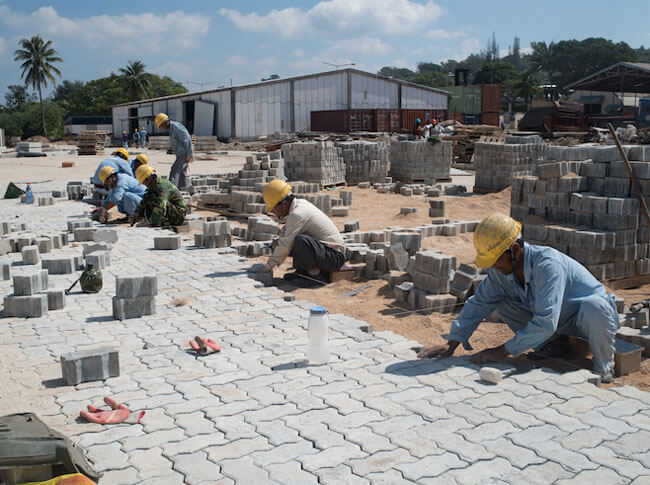
By mid-2017, when work on the wharf is completed, tourists arriving by sea will be treated to one of the prettiest landing points in the region. And considering the world-class beauty of the East Santo coast—and how easy it is to get there and back—it’s not unreasonable to ask how long Port Vila will remain the primary port of call in the country.
The numbers have a long way to go, though. The year 2015 saw fewer than 40 cruise ship arrivals, in spite of the fact that Santo was largely untouched by cyclone Pam.
The number of scheduled arrivals for 2016 is quite low as well, largely because of interrupted access to the wharf.
But if we view the new wharf as one piece of a larger puzzle, it may in fact help make a decisive difference in Santo’s growth. Airports Vanuatu Ltd will soon be entertaining expressions of interest for upgrades to Pekoa airport. An upgraded airport and wharf, combined with better roads and utilities, may just be enough finally to entice some serious investment.
One business promotion professional quietly confided that some very large fish are nibbling the bait right now. He’d just entertained one delegation of potential investors from Southeast Asia, and was organising another group visit within the month.
This time for sure, Rocky.
Maybe.



